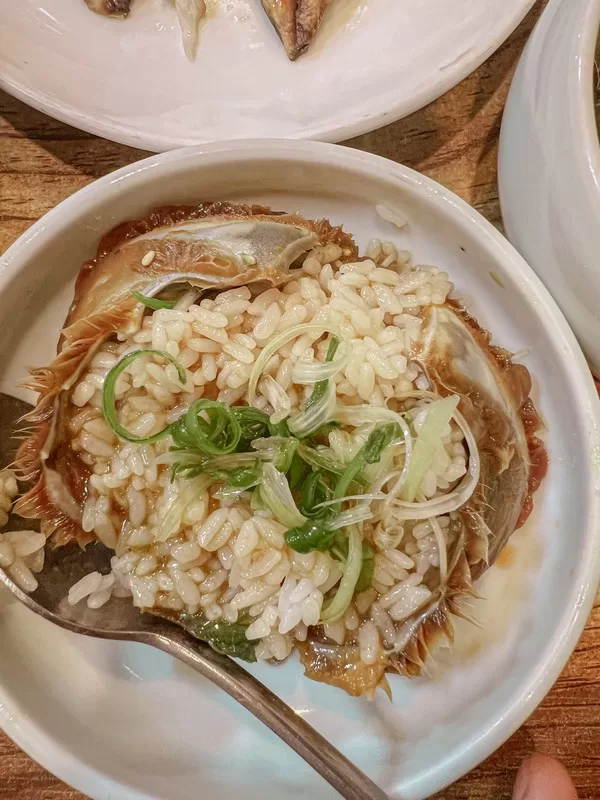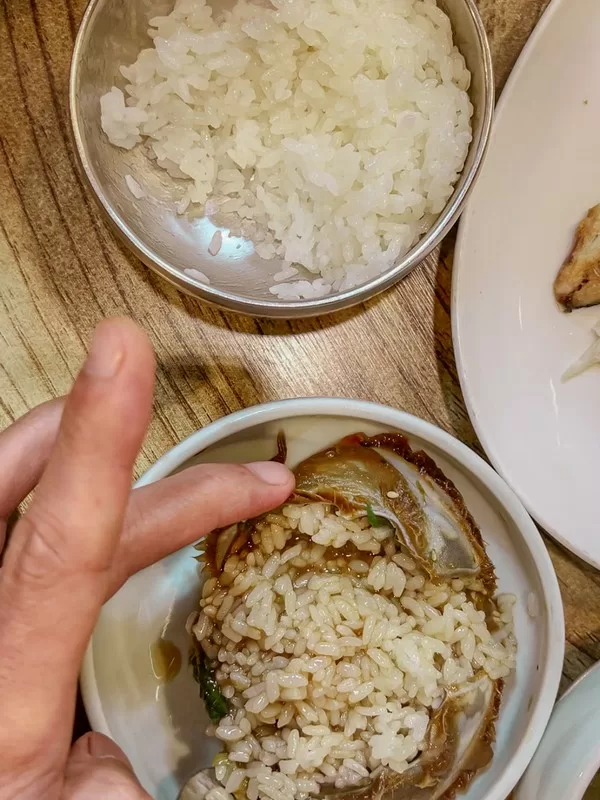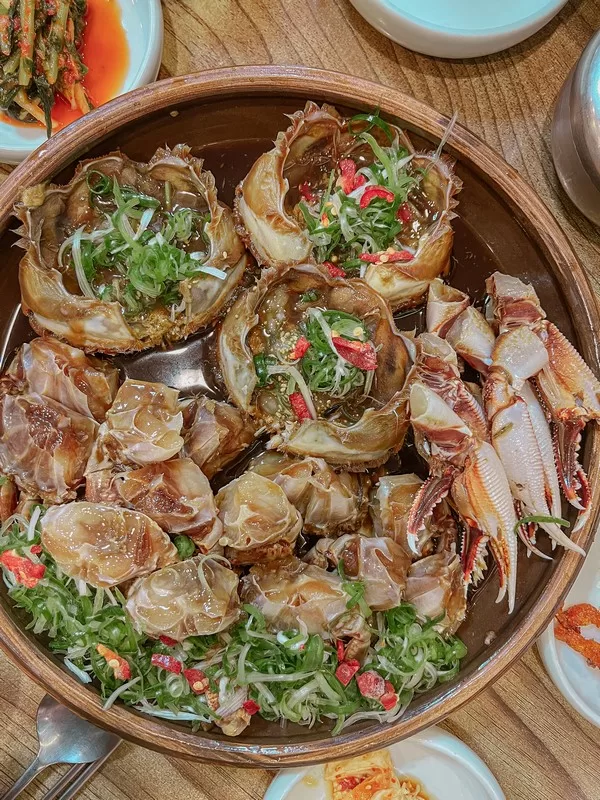Why You Should Eat Ganjang Gejang—Soy Sauce Marinated Raw Crab In Korea
When you think of Korean cuisine, dishes like bibimbap, bulgogi, and kimchi probably spring to mind, but there are some other very delicious delights like ganjang gejang (간장계장), or soy sauce marinated raw crab, that I know the foodies out there will love.
Once you figure out how to eat it, you will be drawn by the incredible umami flavor which will have you coming back for more again and again.

Marinated raw crab might be for the adventurous eater, but it’s good for everyone. Here’s what to know:
- What is Ganjang Gejang?
- How to Eat Ganjang Gejang Like a Pro
- Tips for First-Timers
- Where to Eat Gangjang Gejang in Seoul
- Why Try Ganjang Gejang?
(This post contains affiliate links, which means I receive a certain percentage of a sale if you purchase after clicking at no cost to you. Thank you for your support.)

What is Ganjang Gejang?
Ganjang gejang is a delicacy made by marinating fresh crabs in a soy sauce-based brine. Unlike other Korean dishes, it’s not grilled, stir-fried, or steamed—it’s raw. It’s not really raw when you eat it though as it’s been cured in the soy sauce marinade’s high sodium that preserves the crab.
The process transforms the crab into a flavorful, jelly-like texture, perfect for savoring bite by bite. Ganjang gejang holds a special place in the hearts of umami seekers with its deep, savory notes.
Let’s Learn Korean: The word for umami in Korean is gamchilmat (감칠맛).



The Gyeongsang, Jeolla, and Jeju provinces all have their own types of gejang and it’s an especially representative dish of the Yeosu area of Korea.
My personal favorite and the original recipe of ganjang is the soy-sauce based marinated crab, but there is also a spicy cousin called yangnyeom gejang now, a version with the raw crab marinated in a red chili sauce. This version came about in the Jeolla and Chungcheong provinces.



How to Eat Ganjang Gejang Like a Pro
Don’t be intimidated by the fact that it’s raw or the process of eating it—ganjang gejang is an experience worth diving into. I’ll admit, the first time I was served this dish, I didn’t know where to start and found it quite awkward to eat. Once you learn some pointers though, it gets easier and more enjoyable, trust me.
- Start with the crab legs: Grab a leg, give it a gentle twist to remove it, and suck out the jelly-like flesh. It’s a satisfying burst of flavor in each bite. You can use scissors that are usually on the table to cut the legs into smaller, manageable pieces.
- Next lightly bite the shell: After the ends of the legs, move on to the fuller ends. You’ll put the entire piece into your mouth and bite down lightly while sucking to get out the big pieces. Don’t bite too hard or you’ll end up with shell in your mouth.
- Save the body shell for last: The shell houses the crab’s roe and intestines. My husband shows off above how to best eat it: mix rice directly into the shell, mix it all around, and then scoop out every last bit of deliciousness.
- Balance the saltiness: If the soy sauce flavor feels strong, pair it with rice or wrap it with dried seaweed (gim or gamtae) for a perfect bite.
- Don’t waste the sauce: The leftover soy sauce marinade can be kept and used to elevate other dishes, like drizzling over a fried egg or rice bowl.



Tips for First-Timers
- Timing is everything: The spring and autumn are the best seasons to try ganjang gejang. However, you can find delicious options year-round, as many restaurants freeze crabs for consistent quality.
- Freshness first: Restaurants usually prepare the crab for you on-site, but if you order takeout, be prepared to cut and portion the crab yourself. It’s a hands-on experience that adds to the fun!
- Go local: While Michelin Guide-approved spots have put ganjang gejang on the global foodie map, smaller local restaurants often offer equally amazing versions at a slightly lower price point. Expect to pay around 35,000–50,000 KRW ($30–$40) per serving.
The Rice Thief (밥도독): Gejang is called the “rice thief” because the saltiness and savory taste of the marinated crabs arouses the appetite so that one does not realize how much rice they are eating.
Where to Eat Gangjang Gejang in Seoul
There are a number of restaurants in Seoul to try the delicious ganjang gejang. There’s even a street known as “Gejang Alley” in Gangnam’s Sinsa-dong.
Gebangsikdang (게방식당): Created by fashion marketer Bang Geon-hyuk and his parents, seasoned veterans of the marinated crab trade, the restaurant draws a trendy crowd with its modern design and extensive menu of raw crab dishes. For those who prefer a hassle-free option, they offer crab flesh and roe served over warm rice, eliminating the need to deal with shells.
- Address: 17 Seolleung-ro 131-gil, Gangnam-gu, Seoul (서울 강남구 선릉로131길 17)
- Hours: Monday – Saturday: 11:30am ~ 9:00pm (Breaktime: 3:00pm ~ 5:30pm)

Jinmi Sikdang (진미식당): For over a decade, this modest yet bustling restaurant has specialized exclusively in raw soy-marinated crabs. Each day, the freshest local blue swimmer crabs from the west coast are prepared using the kitchen’s signature soy sauce marinade. Only a limited quantity is made daily to ensure freshness, so latecomers might find the crabs sold out.
- Address: 186-6 Mapo-daero, Mapo-gu, Seoul (서울 마포구 마포대로 186-6)
- Hours: Monday – Saturday: 12:00pm ~ 8:00pm (Breaktime: 3:30pm ~ 5:00pm)
Hwa Hae Dang (화해당): This is the first Seoul location of the renowned Taean County restaurant from Korea’s west coast. Aptly named “Flower Crab House,” the restaurant specializes in soy sauce-marinated blue crab, celebrated for its naturally sweet meat. Each spring, local crabs are harvested at peak freshness, flash-frozen, and prepared in Taean before being sent to Seoul.
- Address: 15 Gukhoe-daero 62-gil, Yeongdeungpo-gu, Seoul (서울 영등포구 국회대로62길 15)
- Hours: Tuesday – Saturday: 11:00am ~ 9:00pm (Breaktime: 3:00pm ~ 5:30pm)


Why Try Ganjang Gejang?
Ganjang gejang is a true hidden gem. While live octopus or Korean BBQ often take the spotlight in travel guides, ganjang gejang remains a rather nice secret. Its nuanced flavors and unique preparation make it a must-try for adventurous eaters.
Crabs are also healthy. They are rich in protein, which helps against obesity and geriatric diseases. They are also good for heart disease, high blood pressure and liver trouble, and also a great seafood for children who need calcium for strong bones.
Trust me—after just one bite of that sweet, briny, soy-infused crab, you’ll understand why it’s earned its nickname as the ultimate “rice thief.”
Did you like this post? Pin iT!



